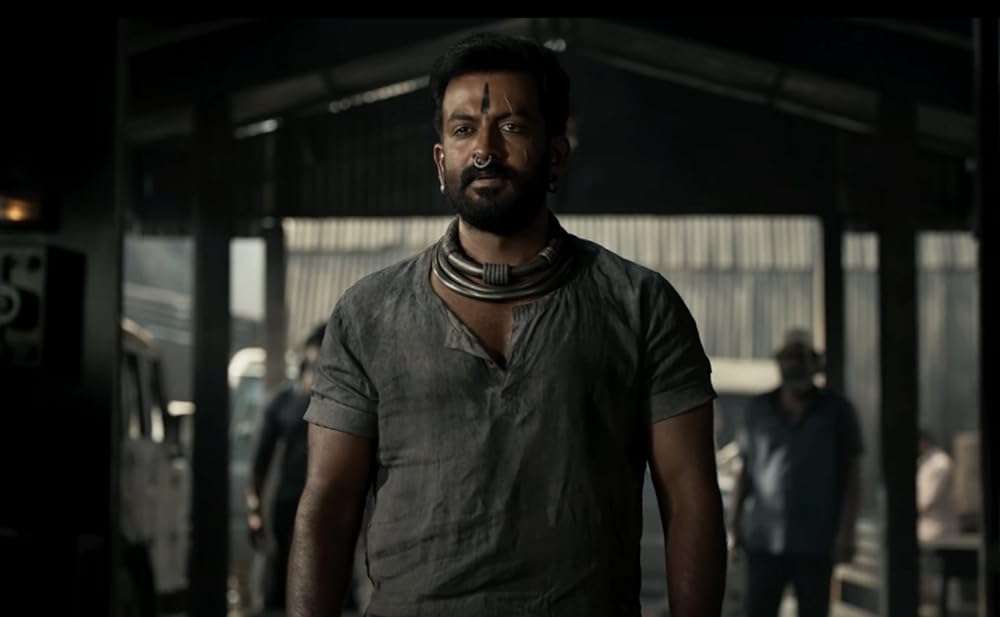Salaar (Original Title – Salaar: Cease Fire – Part 1) Movie Review: Having not watched any Prashanth Neel films previously, I chose to watch KGF: Chapter 1 (2018) to understand his directorial style and the voice he possesses. Founding his protagonist on the inspiration from Deewar’s Vijay, Rocky appears more like a myth in Neel’s universe than a real person himself. We are made aware of the tragedy he went through that also caused him to take a certain path in life, but what he did to become what he is remains behind a veil of ignorance. His actions are based on conscious choices, but there are no justifications for his motivations. Therefore, I felt increasingly alienated from the protagonist himself. In one of the sequences where Rocky’s arrival is anticipated and is being foretold with ample confidence, I was reminded of a sequence from Sunny Deol’s Ghatak.
In this sequence from Ghatak, Katya, the antagonist, has announced to keep all shops closed but Shivnath, the protagonist’s brother, dares against the diktat. All his allies are requesting him to shut down the shop lest Katya’s wrath will fall upon all of them. Enters one of Katya’s goons, who starts intimidating the shopowners but is immediately confronted by Kaashi. The goon, being no match for Kaashi, brings his aid, who gets knocked by a single punch from Kaashi. In this small sequence, Kaashi’s arrival is neither foretold nor hyped to be that of a messiah. His challenge to the power elite is grounded and purely motivated by survival. As an audience, I root for him because I see his actions being molded by adverse circumstances. All his choices seem to be outcomes of him being cornered and pushed to the edge and not the consequences of his aspirations.
The alienation with Rocky exists because even though he eventually rebels against a tyrannical state, it is motivated by his aspiration for power and not survival. Evoking KGF is pertinent to understanding the case of Salaar. Both films are representatives of a changing trend: the substitution of justified causes with hyper-stylized violence to ensure audience engagement. The audience, which once was considered an associate of the protagonist and, by virtue of association, an ally in his revolt, has now been converted into a passive consumer of violence. I sit through Salaar or KGF not because I want to cheer for the protagonist to reach as he aspires but because I am extracting entertainment from the havoc he causes in the path.
The last time we witnessed a change in the identity of our protagonists in commercial cinema, it was the substitution of the working-class hero struggling in the socioeconomic reality with a neoliberal ignorant pretending to be a romantic and possessing and exploiting his sociopolitical capital. Many argue that the working-class hero never left the non-Hindi commercial space, but in fact, the expansion of consumerist choice changed the very nature of the struggle of this working-class hero. This hero became a state agent, a lost prince, or an aspiring demon. His revolution occurred at his convenience and upon his will, and not because he was pushed to the edge of survival. This figure of a “convenient rebel” is symptomatic of the neoliberal illusion that has captured the imaginations of everyone in our nation-state.
We have become subjects of a vicious cycle of violence in which the oppressed, instead of allying with others oppressed like them, aspire to become one of the oppressors to escape powerlessness. Powerlessness is being countered by an effort of power acquisition rather than the elimination of capital from which power is derived. The only connecting attribute remains the experience of poverty and, in many cases, a self-sacrificing mother. All these protagonists, Pushpa Raj from Pushpa, Rocky from KGF and Deva from Salaar, have identical struggles with poverty and a complex relationship with their mother. The vital exercise that now remains is to identify the elements that render Salaar different despite the replication of institutionalized tropes.

The first identifier would be Neel’s attempt at crafting a multi-genre mix within the same narrative at the cost of incoherence. The routine “masala” elements are infused into separate sequences, each mimicking the tone of a genre film, action, political drama, and zombie thriller, each of which contains an action set piece. Neel imagines a monarch-military state isolated from the law of the world but with considerable geopolitical significance due to its resourcefulness and muscle. Brute strength, whether individual or communal, is the only power determinant in this world, and hence, violence is the norm. It is applied that violence is in the inheritance of the people/monarchs of this world; as natural a human trait as hunger.
Neel classifies most people in this universe as demons, including his protagonist, and implicates them to have an appetite for violence. Therefore, the protagonist, Deva, played by Prabhas, is never given the appeal of a hero. He is likened to a devil, an animal. His role is that of a savior, nevertheless. But who is he saving? In Salaar, at least, he isn’t rescuing people out of misery but instead furthering the interests of his kith and kin. As a consequence, the audience is purely driven by the aesthetics of this universe and the movements within it, not by the belongingness felt for the protagonist.
Salaar is an incomplete introduction, almost a preliminary founding of a myth. It begins with multiple narratives and firmly establishes the context of its universe. However, the multiple narratives do not converge. In the process, Salaar becomes a display of gimmicky editing, posing to be an experiment that works during what can be called Varadha’s (played by Prithviraj) “humiliation arc” but fails during the “Countdown to Ceasefire” sequence. That being said, Neel’s direction is more confident and, in many cases, smart. One of the smartest cases would be the utilization of Prabhas.
Prabhas is definitely a rebel star who rebels against the institution of acting. Making him speak can render your action film into a disaster thriller, with Prabhas being the source of disaster that detaches a narrative expression from its intended emotional outcome. Therefore, all Neel does is to make him stand and have precisely choreographed mobility mostly excluding that of his mouth. As a result, Prabhas “looks” stunning. The first action set piece he is accorded also happens to be the finest in the film. What follows only attempts to live up to the anticipation. While previously, action sequences in films were presented mostly from the side and the front, they are getting increasingly shown from the back or extremely low angles in order to hide more and reveal less.
There is a simultaneous attempt to surprise the audience, not by showing them what the actor is doing but by revealing to them the immediate outcome of the action on its victims. This “hide and reveal” tactic is getting institutionalized in Indian action filmmaking. What has also changed and is being cemented now is the treatment random minions of antagonists are met with. In such hypermasculine action cinema years ago, they were beaten up to the point of exhaustion from which they wouldn’t bounce back, whereas now they are immediately killed. The inception of this tradition can be found in copaganda films that worked hard to normalize extra-judicial killings until we had protagonists who kill without hesitation unless it’s a woman or child.
Selective empathy is dangerous. As a certain strata of humanity continues to rage against Israel’s genocide of Palestinians, a number of people are desperately urging to include men as equal victims when people cry for the women and children killed. To iterate this fact in this review is to highlight the numbness we have developed against brutal, physical violence against men in films which doesn’t quite work the same insensitive way when it is against women and children, for whom the act of saving is almost instinctive to the hero.
One critical difference between Neel’s heroes and the heroes of other filmmakers, such as Nelson, director of Jailer, is that Neel never calls Rocky or Deva as anything other than monsters. What this reveals is that Neel is exploiting his protagonists to run his “Masala” entertainers, protagonists he doesn’t actively endorse (but those who get endorsed regardless by virtue of the film’s structure), preach, or like. This is why even if his films are only symptomatic of pathological cultural corrosion and the ignition of capitalist-conservative sympathies, he continues to be an interesting filmmaking voice.




![First Love [2019] Cannes Review- A Hilarious Action Thriller from Takashi Miike](https://79468c92.delivery.rocketcdn.me/wp-content/uploads/2019/05/first-love-teaser-11-cropped-e1556117153197-768x432.jpg)




![And Then We Danced [2019] Cannes Review – A Georgian combination of Call Me By Your Name & Whiplash](https://79468c92.delivery.rocketcdn.me/wp-content/uploads/2019/05/and-then-we-danced-high-on-films-768x432.jpg)